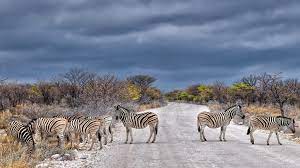Etosha History – The Etosha Pan and the area that would later come to be known as Etosha National Park was first discovered by Europeans in 1851, when explorers Charles Andersson and Francis Galton came to the wild region in the company of Ovambo traders. Etosha can be loosely translated as “Great White Place” in the Ovambo language. The Etosha pan is undoubtedly, massive. It is the most distinctive feature of the park and can even be seen from space. It is believed that it was formed over 100 million years ago and is 130 km’s long and up to 50 km’s wide in certain places.
 What does Etosha mean? The word “Etosha” comes from a Ndonga word meaning “Great White Place.” This refers to the Etosha pan, a 120-kilometre (75 mile) long dry lake bed which makes up a large part of Etosha National Park. Even though it has changed size many times and at one time ran from the skeleton coast to the edge of the Etosha pan (then it was 99.526 sq km), the current size is 22.000 sq km. But while both parks are similar in size, the 2 game reserves are not comparable in terms of the number of camps and roads.
Namibia, then known as South-West Africa, was proclaimed a German protectorate by Otto von Bismarck in 1884. The conquest of German South-West Africa by South Africa forces during World War I resulted in its subsequent administration by South Africa under a 1920 League of Nations mandate. Etosha is most famous for its extensive salt pan. This salt pan is so big that it can be seen from space. The pan provides striking views and breathtaking backdrops to your game-viewing and wildlife or landscape photographs. Elephant at a water pan in Etosha National Park, Namibia.
The Kruger National Park is one of the largest game reserves in Africa, covering an area of just under 20 000 square kilometres (7 500 sq/miles). It is about the size of Israel, slightly smaller than Belgium and about the third of the size of Ireland. We would advise staying at least 3 full days but you can easily spend 4 to 5 days in Etosha if you also include the western area, which we would advise you to do.
We would advise staying at least 3 full days but you can easily spend 4 to 5 days in Etosha if you also include the western area, which we would advise you to do. We would advise staying at least 3 full days but you can easily spend 4 to 5 days in Etosha if you also include the western area, which we would advise you to do.
You really do need to have a robust travel insurance policy for Namibia, Self driving in Namibia is of course safe but due to the terrain and landscape there are so many potential accidents or minor problems with the car that could happen. Namibia is a peaceful country and not involved in any wars. Since the end of the Angolan civil war in 2002, the violence that spilled over into the northeastern regions of Namibia, is no longer an issue. The security situation along the Namibia–Angola border has also improved with peace in Angola.
What does Etosha mean? The word “Etosha” comes from a Ndonga word meaning “Great White Place.” This refers to the Etosha pan, a 120-kilometre (75 mile) long dry lake bed which makes up a large part of Etosha National Park. Even though it has changed size many times and at one time ran from the skeleton coast to the edge of the Etosha pan (then it was 99.526 sq km), the current size is 22.000 sq km. But while both parks are similar in size, the 2 game reserves are not comparable in terms of the number of camps and roads.
Namibia, then known as South-West Africa, was proclaimed a German protectorate by Otto von Bismarck in 1884. The conquest of German South-West Africa by South Africa forces during World War I resulted in its subsequent administration by South Africa under a 1920 League of Nations mandate. Etosha is most famous for its extensive salt pan. This salt pan is so big that it can be seen from space. The pan provides striking views and breathtaking backdrops to your game-viewing and wildlife or landscape photographs. Elephant at a water pan in Etosha National Park, Namibia.
The Kruger National Park is one of the largest game reserves in Africa, covering an area of just under 20 000 square kilometres (7 500 sq/miles). It is about the size of Israel, slightly smaller than Belgium and about the third of the size of Ireland. We would advise staying at least 3 full days but you can easily spend 4 to 5 days in Etosha if you also include the western area, which we would advise you to do.
We would advise staying at least 3 full days but you can easily spend 4 to 5 days in Etosha if you also include the western area, which we would advise you to do. We would advise staying at least 3 full days but you can easily spend 4 to 5 days in Etosha if you also include the western area, which we would advise you to do.
You really do need to have a robust travel insurance policy for Namibia, Self driving in Namibia is of course safe but due to the terrain and landscape there are so many potential accidents or minor problems with the car that could happen. Namibia is a peaceful country and not involved in any wars. Since the end of the Angolan civil war in 2002, the violence that spilled over into the northeastern regions of Namibia, is no longer an issue. The security situation along the Namibia–Angola border has also improved with peace in Angola.
